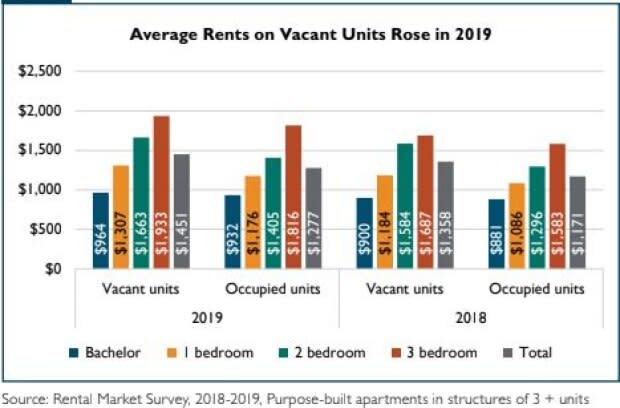Rental vacancies up in Ottawa, but so's the rent
Rental apartments in Ottawa became slightly easier to find but significantly more expensive last year, according to an annual update from the Canada Mortgage and Housing Corporation (CMHC).
The average monthly rent increased by 8.4 per cent in 2019, from $1,174 to $1,281, driven largely by the asking price for smaller units. The average one-bedroom apartment rose from $1,184 per month in 2018 to $1,307 per month last year, while a two-bedroom increased from $1,584 to $1,663.
"Western Ottawa and surrounding areas — the zone that includes Kanata — had the highest and fastest-growing average rent for vacant two-bedroom units. Asking rents in Kanata were 62 per cent higher than the city's average, likely contributing to an increase in the vacancy rate," the report noted.

But it was the smaller units that drove the increase in vacancy, too, according to the CMHC.
"By bedroom count however, only the rise in the vacancy rate for bachelor units was significant, while movements in the vacancy rates for all other bedroom types were not statistically different from 2018," said the report.
Vacancy highest near U of O
The vacancy rate for purpose-built rentals rose only slightly, from 1.6 per cent in 2018 to 1.8 per cent last year.
The demand for rentals continues to increase in Ottawa as the city's population grows. International students attending the city's universities and colleges are a key driver of rental demand, the CMHC said.

Nevertheless, the vacancy rate in Sandy Hill/Lowertown, near the University of Ottawa, was the city's highest at 2.7 per cent, followed closely by 2.6 per cent downtown and 2.3 per cent in Chinatown/Hintonburg.
Altogether, 1,233 purpose-built rental units were added to the city-wide stock in 2019, according to CMHC.
The steady demand and tight rental market may have encouraged condo owners to get in on the game last year, with a 3.3 per cent increase in offerings in 2019 following a modest decline in 2018.

